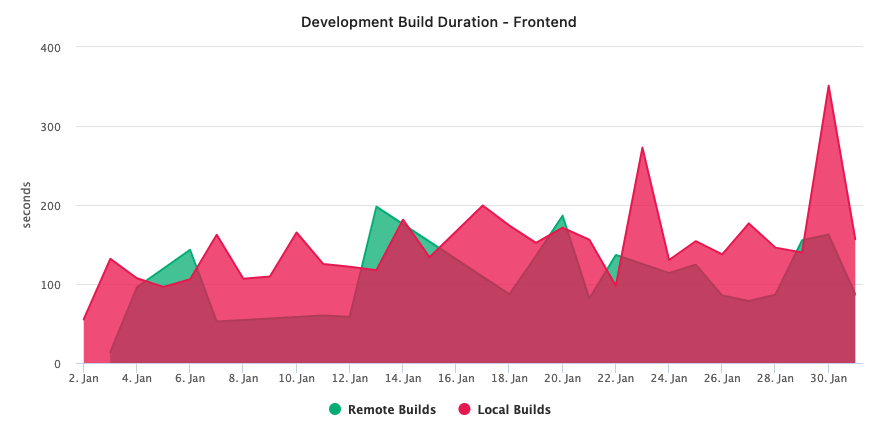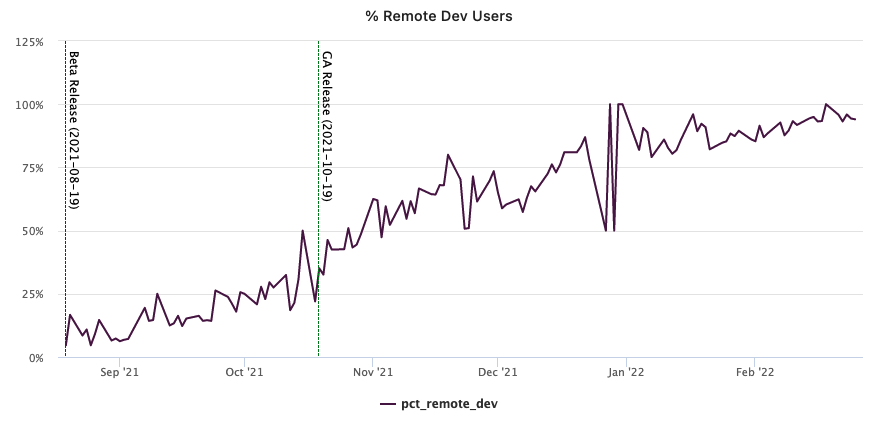Remote Development Environments (RDEs) / Cloud Development Environments (CDEs) are in vogue. But what can you expect from RDEs? We present 5 companies and their results in this blog post.
ToC
#1 Slack
Slack launched a project to develop a remote development environment. The project removed the limitations of Slack’s existing workflows and improved developer productivity by providing a new, isolated development environment on demand. The new solution has removed constraints on the local development facility and eliminated much of the associated maintenance.
Results:


#2 Uber
Uber faced the following challenge: a large, fragmented code base spread across thousands of repositories with different programming languages, build and configuration tools. To improve developer productivity, Uber implemented a remote development environment called Devpod. Devpod led to faster build times, improved security, setup time and resulted in an almost maintenance-free environment.
Results:




Report: https://www.uber.com/en-RO/blog/devpod-improving-developer-productivity-at-uber/
#3 Monday
Monday has grown rapidly and has had to adapt its release and deployment processes and development environment to meet its new needs. New features are released quickly at Monday. The development environment had to be aligned with this and become more flexible. However, it could take days until the environment was ready for use. This led to difficulties with onboarding. There were also problems with the required services – these slowed down the developers’ laptops a lot. “At some point it became almost impossible to run more than a few microservices at a time.” A new solution was needed that was simple, reproducible, had similarities to the production environment and did not cause laptops to crash. Monday then turned to a tool that provides Cloud Development Environments. The increase in productivity has been huge, according to Monday. The onboarding process has improved and the development environment is ready to use immediately.
Report: https://engineering.monday.com/development-environments-in-the-cloud/
#4 Stytch
At Stytch, they identified 5 areas of productivity loss: too many services, too much contextual knowledge was required for development, setting up their dashboard was time and staff intensive, and there were problems with configuration and testing. Three solutions were considered: for example, running all services locally in Docker. In the end, however, only cloud development environments met all the requirements. Stytch sees the biggest advantages of such an environment in centralisation, scaling and efficiency.
Report: https://stytch.com/blog/remote-dev-1/
#5 LinkedIn
Especially laptops with limited performance, CI build errors and inconsistencies between local and CI builds were a problem at LinkedIn. The company wanted to solve this with Remote Development Environments. These are containers that contain all the tools and packages.
Results:
Reduce initial set-up and build times from 10-30 minutes to just 10 seconds.

Report: https://engineering.linkedin.com/blog/2021/building-in-the-cloud-with-remote-development
Whitepaper
Whitepaper: Full list of CDE vendors (+ feature comparison table)
Get an in-depth look at how Cloud Development Environments work and compare all the vendors.
Get the whitepaperSummary
Remote development environments solve typical problems that frustrate managers and developers, but are often simply accepted.
The most common problems are:
- Dissatisfaction with the set-up and maintenance of the development environment.
- Power-intensive processes and services that bring laptops to their knees.
- Complex onboarding.
Some of the companies listed here have developed their own tools. This is not always possible or profitable. With Cloudomation, you get a solution that allows you too to get started with remote development environments – without in-house tooling development efforts. Learn more: Cloudomation DevStack.
Subscribe to the Cloudomation newsletter
Become a Cloudomation Insider. Always receive new news on “Remote Development Environments” and “DevOps” at the end of the month.





